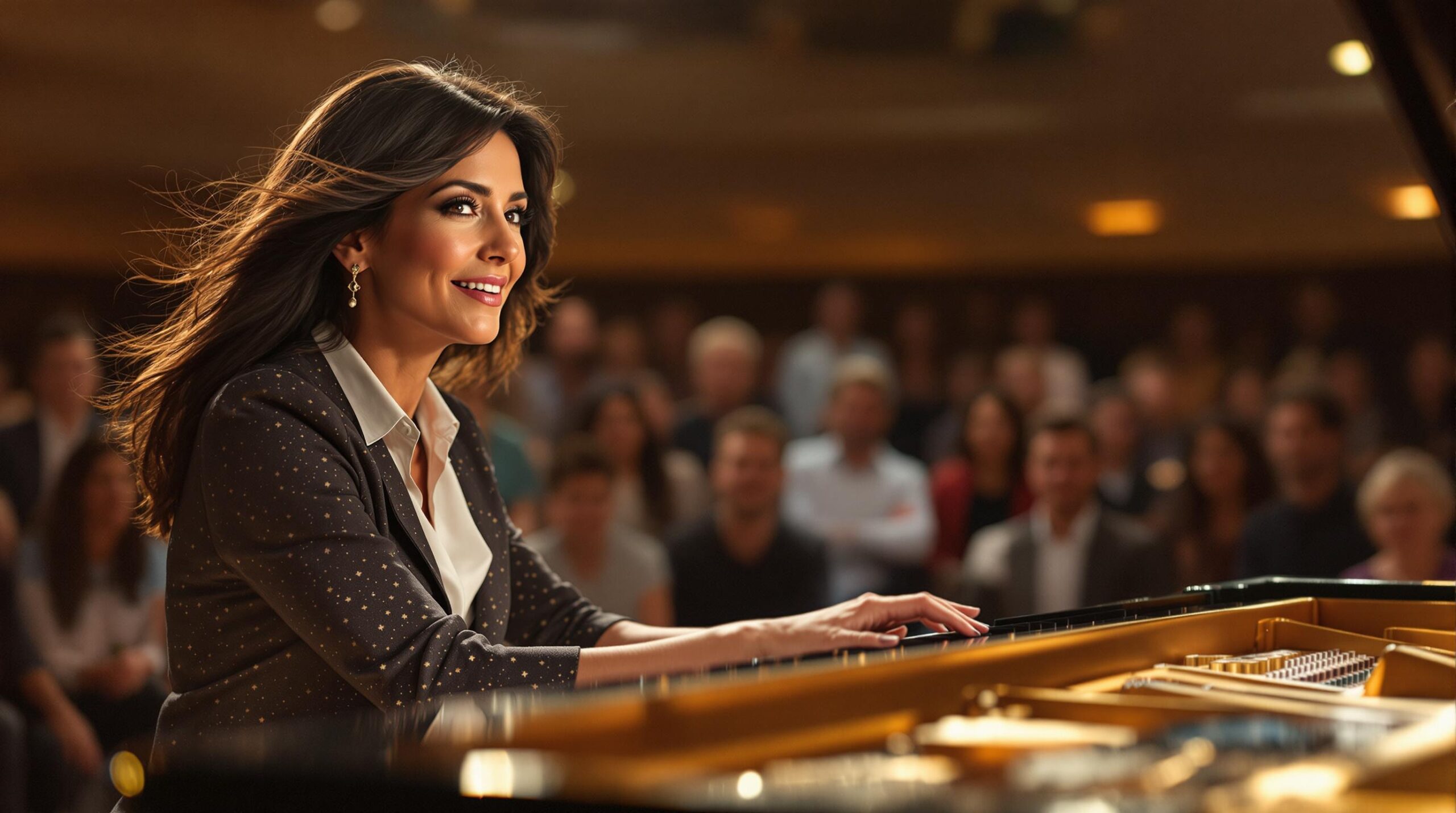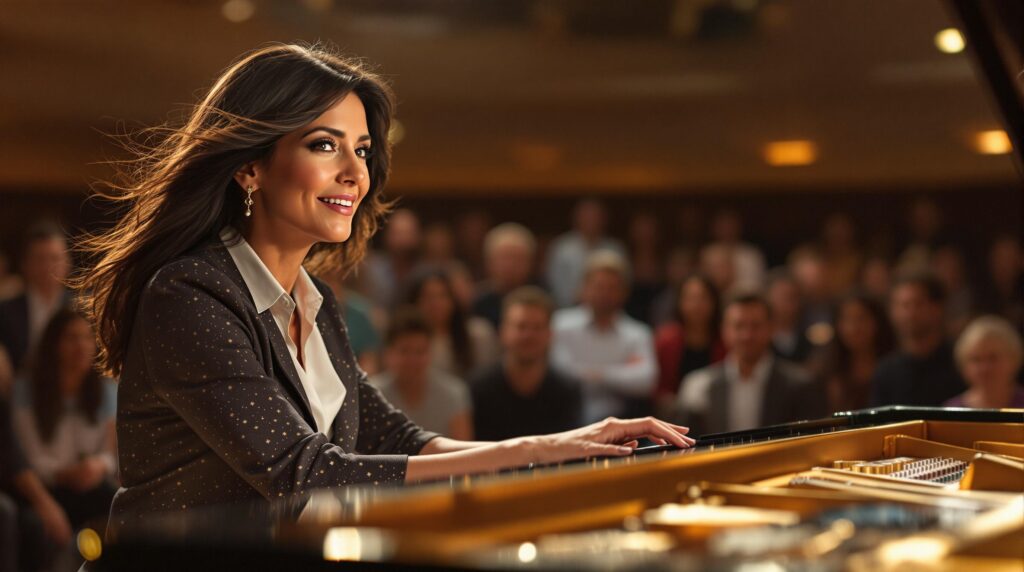
When performing on stage, your body language can elevate your piano performance and deeply connect with your audience. Here’s how to improve your stage presence:
- Maintain Good Posture: Stand or sit tall, relaxed, and confident.
- Express Emotion Through Your Face: Match your facial expressions to the music’s mood.
- Move Naturally: Let your hand and arm movements flow with the music.
- Engage the Audience: Use eye contact and subtle gestures to connect with listeners.
- Confident Stage Entry and Exit: Walk on and off stage with poise, acknowledging the audience.
- Rehearse in Performance Clothes: Ensure your attire is comfortable and doesn’t restrict movement.
- Accept Applause Gracefully: Bow with intention, smile warmly, and show gratitude.
These techniques, practiced consistently, can transform your performance into a memorable experience for both you and your audience.
Stage Presence is a SKILL: How to Master It
1. Keep Good Posture
Standing tall with a relaxed posture can do wonders for your technique and stage presence. It helps you breathe better, reduces muscle strain, and makes you look confident. This strong stance also allows for smooth, expressive movements while performing.
2. Match Face to Music
Use your facial expressions to mirror the emotion of the music, helping the audience connect with its mood right away. This works hand-in-hand with the confident posture we talked about earlier.
Think of your face as part of the performance. Show passion during powerful moments and softness during quieter sections. Let your emotions shine through to create a stronger bond with the audience and make your performance more memorable.
3. Move Hands and Arms Naturally
Your hand and arm movements are a big part of delivering a polished piano performance. The goal is to let your movements flow with the music rather than forcing anything that feels unnatural.
For powerful sections, let your arms move energetically in response to the music. For example, during fortissimo parts, your arms might naturally lift higher off the keys, creating a connection that feels organic rather than exaggerated.
In softer or more delicate parts, keep your movements smaller and more controlled. Let your hands stay close to the keys, using gentle, smooth motions that reflect the music’s intimacy. This subtle approach keeps the focus on the finer details of your playing.
Here are a few tips to keep in mind:
- Follow the music’s phrasing: Let your hands and arms mirror the natural flow of the musical line.
- Stay relaxed: Tension in your shoulders or wrists can make your movements look stiff and forced.
- Match the tempo: Align your gestures with the speed and rhythm of the piece.
The key to natural movement is staying connected to the music. When your gestures come from a genuine place, they’ll resonate more with your audience. Practice these techniques during rehearsals so they feel effortless by the time you perform. Recording yourself can also help you see if your movements are enhancing your interpretation or becoming a distraction.
sbb-itb-b8bc1ab
4. Connect with Your Audience
Engaging your audience is just as important as playing the notes. Subtle gestures and body language can transform a technically flawless performance into something truly memorable. Striking the right balance between focusing on your playing and connecting with listeners is key.
Use strategic eye contact and facial expressions to draw your audience into your interpretation. Here are a few moments to consider:
- Before placing your hands on the keys
- During pauses or rests between movements
- In less demanding passages
- As you approach the final notes
- While taking bows after your performance
- During melodic sections to share the emotion of the piece
- Between movements to acknowledge the audience
When playing complex sections, let your focus on the piano shine through your posture and expression. If you’re genuinely immersed in the music, your expressions will naturally convey its mood, helping your audience feel more connected to the performance.
Start building this connection even before you play. Walk to the piano with confidence – shoulders back, head held high. Let your movements feel natural, reflecting your response to the music, rather than forcing interactions that might feel out of place.
For practice, set up chairs to mimic an audience. This will help you get comfortable with engaging listeners, making it second nature during live performances.
5. Walk On and Off Stage with Confidence
How you enter and exit the stage can set the tone for your entire performance. These moments frame your musical expression and leave a lasting impression.
- Stand tall with your shoulders back and head held high as you make your entrance.
- Take steady, measured steps at a calm pace.
- Keep your arms relaxed and maintain a neutral, composed expression.
- Pause briefly to acknowledge the audience before taking your seat at the piano.
Once at the piano, take a moment to adjust your bench. This small action helps you feel in control and can ease any pre-performance nerves.
After your performance:
- Stand up smoothly and at a steady pace.
- Turn to face the audience, acknowledging their applause with a respectful bow or nod while maintaining good posture.
- Maintain eye contact as you leave the stage, walking slowly and calmly.
Stay composed until you are completely out of view. For formal recitals, if the applause continues, consider returning for an additional bow. Use the same deliberate and composed movements to enhance your stage presence.
Rehearse these entrance and exit routines during your practice sessions, ideally in the performance space. This preparation can help ease nerves and ensure you start and finish your performance with confidence.
6. Practice in Performance Clothes
What you wear can directly affect how you perform. The right outfit not only boosts your confidence onstage but also ensures you can move freely. Rehearsing in your concert clothes helps identify any discomfort or restrictions that might interfere with your performance.
Key Areas to Test:
- Sleeve Movement: Make sure your sleeves allow for full, unrestricted arm movement.
- Lower Body Comfort: Check that your pants, skirt, or other bottoms stay comfortable whether you’re standing or seated.
- Footwear: Practice in your performance shoes to ensure they provide proper control, especially if pedals are involved.
Comfort Check During Rehearsals:
- Rehearse your entire setlist in your concert attire to pinpoint any mobility or comfort issues.
- Ensure the fabrics feel good, even during long practice sessions.
Accessories to Avoid:
- Skip jewelry that might create distracting noises.
- Make sure necklaces or other items don’t interfere with your playing.
Taking these steps ensures your focus stays on your performance – not your outfit.
7. Accept Applause Properly
When the applause starts, acknowledge it with gestures that show appreciation and keep the connection with your audience strong.
- Bow with Intention: Make eye contact and offer a slow, deliberate bow at the waist.
- Genuine Smile: Pair steady eye contact with a warm, sincere smile to convey your thanks.
- Relaxed Stance: Stand upright but at ease, letting your arms rest naturally to show your gratitude.
These gestures help you end your performance on a gracious and thoughtful note.
Conclusion
Getting your body language right on stage is key for pianists to create performances that truly connect with the audience. Combining good posture, expressive facial cues, natural movements, and meaningful engagement can turn technical proficiency into an unforgettable artistic moment.
Stage presence isn’t something that happens overnight – it grows with consistent practice and the right guidance. The ability to express emotion through your performance can transform playing notes into telling a powerful musical story.
For those looking to refine their craft, Cooper Piano offers personalized lessons backed by over a century of experience.
Work on these techniques until they feel effortless. This will let you focus on the music while keeping your stage presence genuine and engaging – because nothing connects better with an audience than honest expression.

